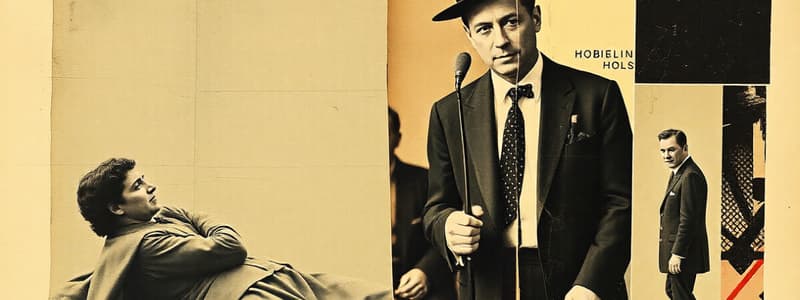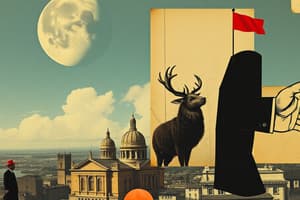Podcast
Questions and Answers
Which of these is NOT a characteristic of a tragedy?
Which of these is NOT a characteristic of a tragedy?
- Characters often experience happy endings (correct)
- Dignified and thought-provoking portrayal
- Emphasis on human flaws and consequences
- Serious subjects like death, disaster, and human suffering
What is the main difference between a melodrama and a farce?
What is the main difference between a melodrama and a farce?
- Melodramas aim for emotional impact, while farces aim for physical humor. (correct)
- Melodramas are serious, while farces are purely comedic.
- Melodramas are typically performed on stage, while farces are more often adapted for film.
- Melodramas focus on realistic situations, while farces use exaggerated situations.
Which type of drama is best known for using songs, spoken dialogue, acting, and dance?
Which type of drama is best known for using songs, spoken dialogue, acting, and dance?
- Melodrama
- Musical (correct)
- Opera
- Farce
Which Muse is associated with the genre of Tragedy?
Which Muse is associated with the genre of Tragedy?
Which of these is NOT an example of a tragedy?
Which of these is NOT an example of a tragedy?
What is the term used to describe a sentimental story designed to evoke sadness?
What is the term used to describe a sentimental story designed to evoke sadness?
What is the significance of ancient Greek festivals honoring Dionysus in relation to drama?
What is the significance of ancient Greek festivals honoring Dionysus in relation to drama?
What is the turning point or high point of a story called?
What is the turning point or high point of a story called?
Which type of plot structure involves events happening in a chronological order, with a clear beginning, middle, and end?
Which type of plot structure involves events happening in a chronological order, with a clear beginning, middle, and end?
What is the term for a long speech delivered by a single character in a play, often revealing their thoughts or feelings?
What is the term for a long speech delivered by a single character in a play, often revealing their thoughts or feelings?
What is the primary purpose of foreshadowing in a dramatic work?
What is the primary purpose of foreshadowing in a dramatic work?
Which literary technique involves the use of specific objects or images to represent abstract ideas?
Which literary technique involves the use of specific objects or images to represent abstract ideas?
What is the main difference between emotional/subjective acting and technical/objective acting?
What is the main difference between emotional/subjective acting and technical/objective acting?
What is the term for the process by which an actor makes the personality of a character visible to the audience?
What is the term for the process by which an actor makes the personality of a character visible to the audience?
Which aspect of acting involves understanding the reasons behind a character's actions and decisions?
Which aspect of acting involves understanding the reasons behind a character's actions and decisions?
What specifically is meant by 'playing the conditions' in acting?
What specifically is meant by 'playing the conditions' in acting?
What is the primary element of acting that involves understanding and sharing the feelings of another person?
What is the primary element of acting that involves understanding and sharing the feelings of another person?
Which element of speaking in drama refers to the clarity and pronunciation of words?
Which element of speaking in drama refers to the clarity and pronunciation of words?
In the context of acting, what are 'gestures'?
In the context of acting, what are 'gestures'?
What does 'blocking' refer to in a theatrical production?
What does 'blocking' refer to in a theatrical production?
How do technical elements of drama enhance the production?
How do technical elements of drama enhance the production?
Which character type is typically the main character who drives the action of a play?
Which character type is typically the main character who drives the action of a play?
What is the main purpose of supporting roles in a play?
What is the main purpose of supporting roles in a play?
What is the primary purpose of the production designer?
What is the primary purpose of the production designer?
What is the difference between a 'fresnel' and a 'flood' light?
What is the difference between a 'fresnel' and a 'flood' light?
Which of the following is NOT considered a property ('prop') in a play?
Which of the following is NOT considered a property ('prop') in a play?
What is the purpose of 'stage directions' in a play?
What is the purpose of 'stage directions' in a play?
Which type of stage is considered the most traditional and common?
Which type of stage is considered the most traditional and common?
Which of the following is NOT a function of music in a play?
Which of the following is NOT a function of music in a play?
What is the 'house' in a theatre?
What is the 'house' in a theatre?
What is the term for the area on stage farthest from the audience, towards the backstage wall?
What is the term for the area on stage farthest from the audience, towards the backstage wall?
Which type of stage is also known as 'Theatre in the Round'?
Which type of stage is also known as 'Theatre in the Round'?
What is the purpose of the 'apron' in a theatre?
What is the purpose of the 'apron' in a theatre?
Flashcards
Drama
Drama
A portrayal of events through performance and dialogue.
Tragedy
Tragedy
A serious drama portraying human suffering with often sad endings.
Comedy
Comedy
A lighthearted drama intended to amuse, usually ending happily.
Melodrama
Melodrama
Signup and view all the flashcards
Farce
Farce
Signup and view all the flashcards
Musical
Musical
Signup and view all the flashcards
Opera
Opera
Signup and view all the flashcards
Ancient Origin of Drama
Ancient Origin of Drama
Signup and view all the flashcards
Production Designer
Production Designer
Signup and view all the flashcards
Props
Props
Signup and view all the flashcards
Costume
Costume
Signup and view all the flashcards
Lighting
Lighting
Signup and view all the flashcards
Set Design
Set Design
Signup and view all the flashcards
Arena Stage
Arena Stage
Signup and view all the flashcards
Proscenium Stage
Proscenium Stage
Signup and view all the flashcards
Stage Directions
Stage Directions
Signup and view all the flashcards
Up Stage
Up Stage
Signup and view all the flashcards
Down Stage
Down Stage
Signup and view all the flashcards
Plot
Plot
Signup and view all the flashcards
Exposition
Exposition
Signup and view all the flashcards
Climax
Climax
Signup and view all the flashcards
Denouement/Resolution
Denouement/Resolution
Signup and view all the flashcards
Dialogue
Dialogue
Signup and view all the flashcards
Monologue
Monologue
Signup and view all the flashcards
Tone
Tone
Signup and view all the flashcards
Foreshadowing
Foreshadowing
Signup and view all the flashcards
Characterization
Characterization
Signup and view all the flashcards
Empathy
Empathy
Signup and view all the flashcards
Acting Techniques
Acting Techniques
Signup and view all the flashcards
Gestures
Gestures
Signup and view all the flashcards
Blocking
Blocking
Signup and view all the flashcards
Imagery
Imagery
Signup and view all the flashcards
Supporting Roles
Supporting Roles
Signup and view all the flashcards
Study Notes
Drama Definition and Origins
- Drama originates from the Greek words "dráō" (to act) and "drâma" (a play).
- In literature, drama portrays events (fictional or not) through written dialogue (prose or poetry).
- Performances can be on stage, film, or radio.
- English uses "play" for drama and "playwright" for creator, rather than "drama" and "dramatist."
- A playhouse is the building, rather than a theater.
- Greek drama emerged during religious festivals honoring Dionysus.
- Included tragedy, comedy, and satyr plays.
Types of Drama
- Tragedy: Portrays serious issues (death, disaster, suffering) with somber characters and outcomes. (Titanic, Romeo and Juliet, The Fault in Our Stars)
- Comedy: Aims to make audiences laugh with happy endings and lightheartedness, often with clever wordplay. (3 Idiots, Ang Tanging Ina, Kita-Kita)
- Melodrama: Presents profound stories (tearjerkers) with emotional intensity and sentimental elements. (Seven Sundays, Rewind, Anak)
- Farce: Uses physical humor (slapstick, clowning) in ludicrous situations for comedic effect. (The Mask, Home Alone, National Lampoon’s Christmas Vacation)
- Musical: Combines songs, dialogue, acting, and dance. (Frozen, Wonka, Ang Huling El Bimbo Musical)
- Opera: Lines are sung.
Literary Elements of Drama
- Plot: Sequence of events (exposition, rising action, climax, falling action, denouement).
- Linear Plot: Follows a traditional structure.
- Episodic Plot: Consists of parts and chapters.
- Flashback Plot: Includes flashbacks during the story.
- Script: Written words and directions for a play.
- Characters: People portrayed in the drama.
- Setting: Time and place of the play's action.
- Dialogue: Conversation between characters.
- Monologue: One person's extended speech.
- Soliloquy: A monologue revealing a character's private thoughts.
Literary Devices
- Literary Devices: Creative writing methods to convey the author's message, aid visualization, interpretation, and analysis.
- Tone: The overall attitude or mood of a text (shaped by word choice and format).
- Theme: The main idea or subject of a piece of writing (movie, etc.).
- Point of View: Perspective from which the story is told.
- Exposition: Author's explanation within a story (often for background).
- Foreshadowing: Hints at future events.
- Idioms: Familiar expressions with figurative meanings.
- Symbolism: Use of objects or images to represent abstract ideas.
- Imagery: Words that evoke sensory experience.
Performance Elements of Drama
-
Acting: Incorporates body, voice, and face to manifest characters.
-
Two Major Acting Approaches:
- Emotional/Subjective: Actor embodies the role emotionally.
- Technical/Objective: Actor utilizes skills to portray the role without emotional investment.
-
Key to Characterization:
- Internalizing: Understanding the character's inner nature
- Externalizing: Representing the character's true nature.
- Concentration: Focusing all skills and energy on the current task.
- Observation: Closely watching human behavior to portray characters.
- Emotional Memory: Recalling and using past feelings.
- Motivation: The "why" behind a character's actions.
- Playing the Conditions: Factors influencing character actions (time, place, objects, individual state).
- Playing the Objectives: Ways a character achieves goals.
- Energy: The driving force behind performance.
- Empathy: Understanding others' emotions.
-
Speaking: Delivery of lines.
- Breath Control: Proper use of breath while speaking.
- Vocal Expression: Using voice to manifest character.
- Diction: Clarity of speech and pronunciation.
- Projection: Effectiveness of voice in reaching the audience.
- Inflection: Variations in pitch and volume of the voice.
-
Nonverbal Expression: Gestures, facial expression, body alignment.
Technical Elements of Drama
- Technical elements enhance the production by creating mood and atmosphere. Design's impact is significant on audience experience, providing context, setting, and production type.
- Production Designer: Has overall responsibility for design, working closely with the director.
- Set and Props: Physical environment and moveable objects on the stage.
- Costumes: Clothing and accessories for character depiction and period.
- Makeup: Costumes, wigs, body paint for transforming actors into characters.
- Lighting: Placement, intensity, and color of stage lights, communicating environment, mood, or feeling.
- Spot light: Hard-edged, focuses on a character or element.
- Fresnel light: Softer-edged, good overall light.
- Flood light: Wide angled light, less control over spread.
- Strobe light: Flashing light, special effects; jerky actor movements.
- Music and Sound: Adding sounds and music for mood, character, and environment.
- Set: Physical space where the play takes place, setting the mood and environment.
- Set Design: Sets the mood and tells the audience about the characters' surroundings.
Stage Types
- Arena: Stage in the center, audience surrounding.
- Thrust: Stage with the audience on three sides.
- Proscenium: Stage with a frame (arch) separating the audience from the action.
Stage Directions
- Upstage/Downstage: Areas relative to the audience.
- Stage Right/Left: Directions from the actor's perspective.
- Wings: Off-stage areas.
- Apron: Area between the curtain and stage edge.
Studying That Suits You
Use AI to generate personalized quizzes and flashcards to suit your learning preferences.




